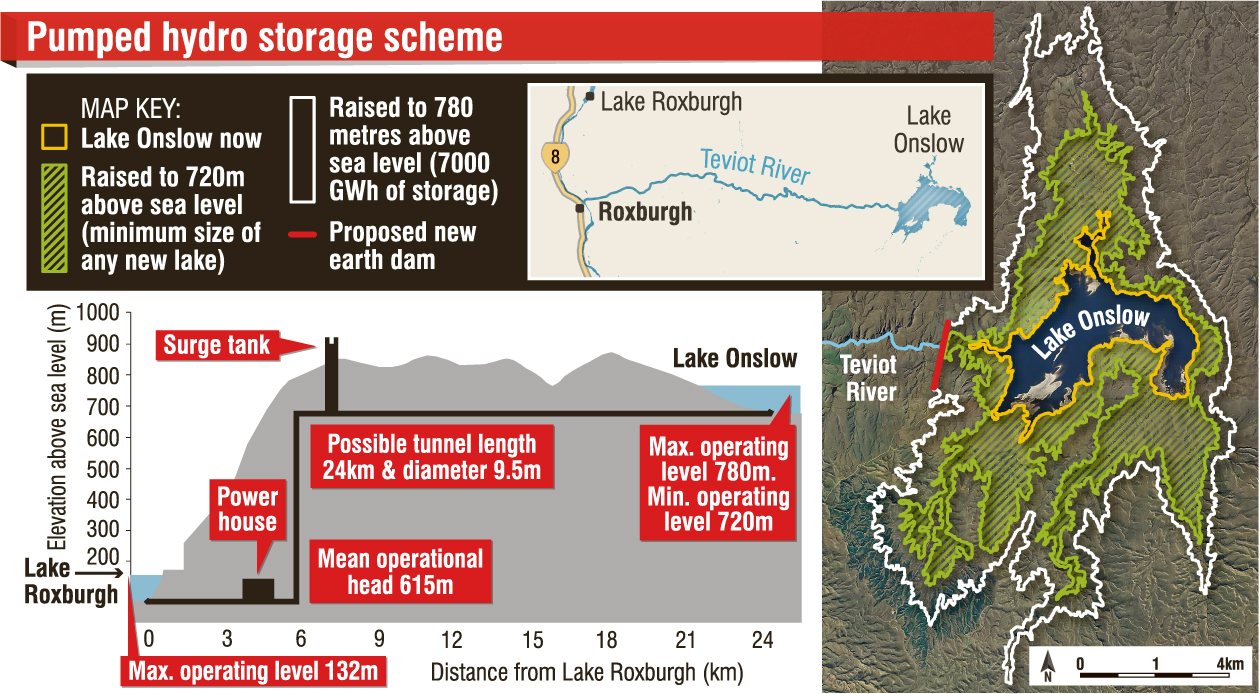
It comes from a Government push to have 100% renewable electricity in New Zealand by 2035 and is recommended by the Independent Climate Change Committee, commissioned by the Government to report on accelerated electrification.
Its report, which also considers electrifying up to half of New Zealand's vehicle fleet by 2035 and increasing the amount of renewable energy used instead of coal or gas, recommends investigating the possibility of pumped hydro storage (PHS) as a way to reduce New Zealand's greenhouse gas emissions.
The best known proposal in New Zealand for a PHS facility, and one that would meet the size of a dry-year need, was to build a new dam on Lake Onslow and a tunnel down to Lake Roxburgh.
The Onslow project was first mooted in 2005 by Earl Bardsley, of the University of Waikato's science and engineering faculty.

Pumped systems operate as conventional hydro-power stations during periods of high electricity demand by releasing stored water from the upper reservoir (Lake Onslow, in this case) through turbines into the lower reservoir (Lake Roxburgh).
During periods of low demand, the upper reservoir is recharged by using lower-cost electricity from the grid to pump water back to the upper reservoir.
A spokesman for Energy and Resources Minister Megan Woods said the Government would announce by the end of the year who would investigate the potential for PHS in New Zealand.
The report said the cost of the Onslow project was "uncertain", but could be between $2.2billion and $4.2billion.
However, pumped schemes carried "large local environmental consequences" and had "substantial impacts on the landscape."
Prof Bardsley said if an Onslow scheme was used to buffer the transition to electrification then "it really would be a big deal nationally - changing our energy scene forever".
He said transitioning to a low-emissions economy in New Zealand would require a "significant increase" in energy storage capacity.
"The only practical option is pumped storage, most probably at Onslow. Preliminary evaluations ... should start as soon as possible because of the long lead time between project consenting and completion for large civil engineering projects".
Prof Bardsley said Onslow pumped storage was "only an option which might not ever be taken up. If constructed, it would not be any time soon and not before full consultation and open discussion".
The ICCC report said any investigation into the Onslow proposal would "need to consider environmental, social and cultural implications" of pumped hydro options, not just technical and economic effects.
Pioneer Energy owns and operates a hydro scheme on the Teviot River, which drains from Lake Onslow, and Contact Energy owns and operates a hydro scheme at Lake Roxburgh.
Representatives from both companies said they were aware of the Onslow PHS proposal, but it was too early to comment before the new study was concluded.
* This story is part of the Otago Daily Times contribution to Covering Climate Now, an international campaign by more than 170 media organisations to draw attention to the issue of climate change ahead of a United Nations summit on September 23. To read more of our coverage, go to odt.co.nz/climate
Comments
I think the proposed lake size should read 500sqkm, not 50.
So, to clarify. The proposal is to spend 4+ billion of NZers money on building a dam that will flood 500 sqkm, with water pumped up hill, from the Clutha river so we have a reserve in dry years, all in an effort to keep electricity prices low while they save the planet from human activity.
The comedy keeps getting better by the day.
50sq km is correct: Ed
500sqkm would almost be the size of lake Taupo, so yes 50sqkm is correct.
The main selling point is that after about 5% of our electricity is produced by wind, the grid cannot take any more (economically) without significantly more energy storage, the onslow scheme would solve this problem, and up the wind saturation to around 30% of the total electricity supply single handedly. The instability provided by renewables is the biggest drawback and has to be remedied. Sometimes the wind doesn't blow and sometimes the sun doesn't shine. If we wish to use renewables and always want the lights and heating to be available then adding electricity storage is the only option.
Lithium batteries have a limited lifespan and would (depending on specifics of manufacturing) cause more environmental damage than just using coal or natural gas. A new storage lake wont have as many drawbacks as old hydro lakes like the schemes of old, not flooding entire towns is a good start. There are tradeoffs with every project but it looks like the onslow scheme is the best option.
This idea is outrageous: even more damage to the environment than the damage that has already been done by agriculture. Why is this government not considering other sources of renewable energy: there is so much potential for solar energy in New Zealand compared to countries in Europe where solar power is already heavily invested on. To me it feels like the hydropower companies do a lot of lobbying with the government. Subsidize the installation of solar panels on roofs of houses and this problem gets solved too, and it is does not cause damage to the environment.
Solar energy generates at the wrong time of the day — not during 7-8:30am and 5-8pm, when domestic consumption is at its highest. So that requires that the solar energy is stored somewhere. Either a lot of batteries, or a pumped storage scheme like this. Or you have a lot of other power plants sitting idle during the day ready for the peak load. All of these options come with substantial environmental costs.
To clarify, this scheme will not generate any electricity, it will only store electricity generated elsewhere. Pumped storage has very equivalent efficiencies as lithium batteries (80 - 90 % energy recovery), with significantly longer lifespan, and significantly less environmental impacts (co2). This will enable wind and solar energy to be more effective by storing excess power when its windy and sunny, and discharging when its a calm evening and demand is at its highest, providing a more reliable grid, and allowing us to less overbuild the renewable generation (which would cause significanly more cost and pollution). I think a lack of understanding by the public will be the schemes biggest downfall. There is also a lot of solar potential that the lake provides, a large flat area, might as well put a sizable solar farm on the surface of the lake too. To be clear there are tradeoffs at every step and there is no best option for every outcome desired, but the coming business case will evaluate all these.












